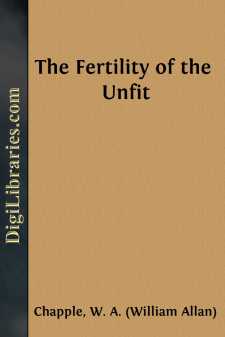Categories
- Antiques & Collectibles 13
- Architecture 36
- Art 48
- Bibles 22
- Biography & Autobiography 813
- Body, Mind & Spirit 142
- Business & Economics 28
- Children's Books 15
- Children's Fiction 12
- Computers 4
- Cooking 94
- Crafts & Hobbies 4
- Drama 346
- Education 46
- Family & Relationships 57
- Fiction 11828
- Games 19
- Gardening 17
- Health & Fitness 34
- History 1377
- House & Home 1
- Humor 147
- Juvenile Fiction 1873
- Juvenile Nonfiction 202
- Language Arts & Disciplines 88
- Law 16
- Literary Collections 686
- Literary Criticism 179
- Mathematics 13
- Medical 41
- Music 40
- Nature 179
- Non-Classifiable 1768
- Performing Arts 7
- Periodicals 1453
- Philosophy 64
- Photography 2
- Poetry 896
- Political Science 203
- Psychology 42
- Reference 154
- Religion 513
- Science 126
- Self-Help 84
- Social Science 81
- Sports & Recreation 34
- Study Aids 3
- Technology & Engineering 59
- Transportation 23
- Travel 463
- True Crime 29
The Fertility of the Unfit
Categories:
Description:
Excerpt
INTRODUCTION.
Biology is the Science of Life. It seeks to explain the phenomena of all life, whether animal or vegetable. Its methods are observation and experiment. It observes the tiny cell on the surface of an egg yolk, and watches it divide and multiply until it becomes a great mass of cells, which group off or differentiate, and rearrange and alter their shapes. It observes how little organs unfold themselves, or evolve out of these little cell groups—how gradual, but how unvarying the change; how one group becomes a bone, another a brain, another a muscle, to constitute in three short weeks the body of a matured chick. Those little tendons like silken threads, that run down those slender pink legs to each and every toe, and move its little joints so swiftly that we hardly see them—that little brain, no bigger than a tiny seed, in which is planted a mysterious force that impels it to set all those brand-new muscles in motion, and to dart after a fly with the swiftness of an arrow—all this wondrous mechanism, all this beauteous structure, all this perfection of function, all this adaptation to environment, have evolved from a few microscopic cells in three short weeks.
Biology is the science that observes all this, and enunciates the law that the life history of this animal cell, i.e., its history from a simple unicellular state in the egg, to its complex multicellular state in the matured chick, represents the history of the race to which the chick belongs. If we could trace that chicken back through all its ancestry, we would discover at different periods in the history of life upon the globe (about 100 million years, according to Haeckel) exactly the stages of development we found in the life history of the chick, and arrive at last at a primordial cell.
What is true of the chick is true of all life. This is the law of evolution. It is true of all plant and animal life; it is true of man as an individual; it is true of his mind as well as of his body; it is true of society as an aggregation of individuals. As men have evolved from a lower to a higher, a simple to a complex state, so they are still evolving and rising "on stepping stones of their dead selves to higher things."
Natural selection, or the survival of the fittest, is one of the processes by which evolution takes place. According to this law, only the fittest survive in the struggle for life. Darwin was led to this discovery on reading Malthus's thesis regarding the disproportion between the rates of increase in population and food, and the consequent struggle for existence.
All living organisms require food and space. The power of multiplication in plants and animals is so great that food or space is sooner or later entrenched upon, and then commences this inevitable struggle for existence. In this struggle for life, the individuals best able to conform to their environment, i.e., the best able to resist adverse circumstances, to sustain hardships, to overcome difficulties, to defend themselves, to outstrip their fellows, in short, to harmonise function with environment, survive....


